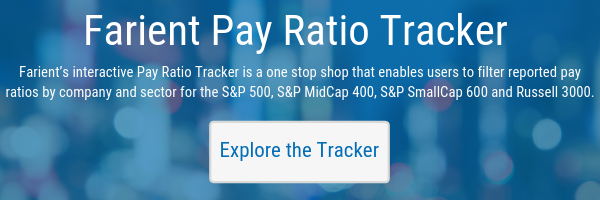Farient CEO Pay Ratio Tracker Update – April 20, 2020
April 20, 2020
The Big Mac & the $1 Pay Pack: Pay Ratios of McDonald’s and Kinder Morgan
Welcome to the sixth installment of Farient’s Pay Ratio Tracker™ update. Each week, we focus on the companies with the highest and lowest CEO-to-median-employee pay ratios. This week, we explore the highs and lows of the first week of April’s pay ratio disclosure with McDonald’s and Kinder Morgan. As a reminder, the CEO-to-median-employee pay ratio is one of the provisions of the 2010 Dodd-Frank Wall Street Reform and Consumer Protection Act implemented in 2018.

McDonald’s: Super Size My Pay!
McDonald’s (MCD), the $21-billion fast food giant marked by iconic “golden arches” across the globe, has frequently come under fire for the wide pay disparity between the top and bottom of the organization. That disparity was brought sharply into focus last week when MCD reported its 2019 CEO pay ratio of 1,939:1, the third highest released to date in 2020 and 6x the median pay ratio reported by Consumer Discretionary companies in 2019.
Two All-Beef Patties, Special Sauce…
After the sudden departure of CEO Steve Easterbrook in late 2019, the Company tapped insider Chris Kempczinski (former President, McDonald’s USA) for the top spot. MCD’s 2019 CEO pay was calculated by prorating each CEO’s pay and combining the two, for a total of $18 million. This blended $18MM is fairly in line with past compensation of the CEO. In contrast, the median employee, a part-time restaurant crew employee located in the United Kingdom, received total 2019 compensation of $9,291. In an effort to ease investor concerns, MCD reported in its pay ratio disclosure that over 90% of CEO pay is performance-based; included in that 90% are annual cash bonus, options and performance-based restricted stock.
Kinder Morgan: Crude Oil, Refined Pay
Kinder Morgan (KMI) is a $13 billion North American energy infrastructure company specializing in oil and gas pipelines. KMI reported a 2019 pay ratio of 0:1, which is reflective of the fact that the CEO, Steven Kean, takes a $1 salary and elects not to participate in the annual incentive program. Moreover, KMI’s CEO did not receive any equity in 2019. Interestingly, Mr. Kean receives equity compensation every few years in large grants of restricted stock; his last was a $16MM grant in 2018. Mr. Kean’s 2019 pay of $7,270 included a $7,269 change in pension, and excluded roughly $1 million in dividend equivalents. KMI reports an alternative ratio including the dividend equivalents of 11:1.
Farient’s Takeaway
While a high pay ratio is almost always indicative of high CEO pay, it can be just as heavily influenced by low median employee compensation. This week’s installment of the Pay Ratio Tracker illustrates how critical it is to consider both inputs before drawing a conclusion. It is also crucial not to consider any company’s ratio in a one-year vacuum. High levels of year-over-year volatility in some CEOs’ pay plans can mask true compensation levels. As always, investors should gather as much context as possible and be aware of all the factors that can influence a company’s pay ratio.
Farient‘s CEO Pay Ratio Tracker™ provides updates on CEO to median employee pay ratio throughout the proxy season. In addition, for real-time information on Say on Pay votes, please visit our Say on Pay Tracker™ at Farient.com.

© 2025 Farient Advisors LLC. | Privacy Policy | Site by: Treacle Media